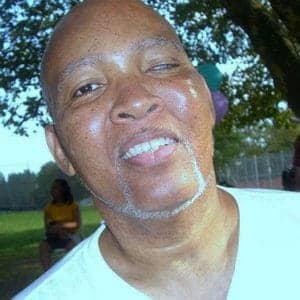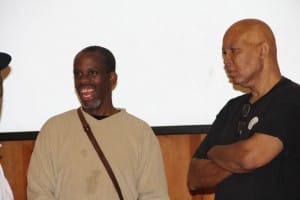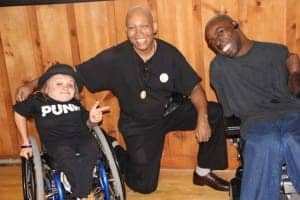by Emmitt H Thrower
Police brutality is at epidemic levels nationwide. Every day a new report of someone brutalized or killed by the police is blasted about on social networks and in mainstream media. While this trend is hardly new, we were just not as aware of the immense scope of it as a community. It has been in the forefront of people’s mind lately, because of all the recorded incidents that are posted on video sharing sites such as YouTube.

Many people have been rudely awakened when they suddenly realize that their peaceful everyday dreams are in fact paralyzing nightmares. Their friendly neighborhood cops have been quietly laid to rest over the past few decades and almost secretly replaced with a brand new post-911 edition. This version comes with no instructions and is not user friendly at all.
With raised awareness comes a responsibility – responsibility to respond to an injustice. We recognize the problems mainly because of the many images presented to us daily of this national onslaught. Most are captured by ordinary citizens on their cellphones or recorded by surveillance cameras.
No longer, in many cases, do we have to rely on the “official story” as told to us by law enforcement as they have spoon fed it to the media. We have eyewitness observers sharing what they saw and often recording it to be placed on YouTube. We can then see for ourselves what’s going on through our own eyes, through our own lenses from our own perspective.
The community of people with disabilities has a different experience of brutality than the ablebodied community. There are of course many similarities. But disability adds another level of difficulty to it all. And being poor, homeless or Black or Brown with a disability makes many of us vulnerable from many additional angles.
Disability is glazed over or not recorded in the official police reports. Nor is the fact adequately represented in the media. The fact that disability is totally absent in most official reports even though it was a factor in the incident’s occurrence is eye-opening. It informs us that for them, disability doesn’t matter. But clearly disability does matter, and our documentary project will make that statement loud and clear.
It is estimated that over 50 percent of the victims of police brutality and police killings nationally have a disability that contributed to the incident. It can only be an estimate because most all law enforcement agencies, including the Department of Justice, do not maintain records or statistics of police involved deaths or abuse. Nor do they record whether the person had a disability and if it was a factor in the encounter.
Why would they not want these stats available? Did they think these stats were not important enough to collect? Congress instructed the attorney general in 1994 to compile and publish annual statistics on police use of excessive force, but this was never carried out, and the FBI does not collect these data either.
It is estimated that over 50 percent of the victims of police brutality and police killings nationally have a disability that contributed to the incident.
In a rare bipartisan vote just before they adjourned for the 2014 year, the House and Senate passed a bill called the Death in Custody Reporting Act. The bill calls for all police departments to report all people killed in custody or during an arrest. This bill originally was passed by Congress in 2000. We paid $1 billion of our tax money for its implementation at the time.
We got a total of one measly inadequate report out of that billion dollar payment. The bill they passed was originally passed in 2000 but expired in 2006. During those years up until that vote in 2014, not much data was collected except for that one year, according to the FBI and most criminologists.
Since the law expired over eight years ago, there were four attempts to reinstate it. They all failed until the vote last year. The bill was stalled until Republican Sen. Rand Paul called on a couple of colleagues and persuaded them to remove their holds, no doubt motivated by the national uproar following the deaths of Eric Garner and Michael Brown.
To get compliance, all that needs to happen is for the federal government to withhold grants and subsidy money until states and local law enforcement comply. They either comply by submitting the reports or they forfeit their federal funds. We know what they will choose. Money matters – and so do we.
But not enough for the House and Senate to include a requirement in the bill that disability stats should also be reported along with those other stats so they can see how disproportionately we are impacted by police brutality and police killings. They estimate that between 300 and 400 people are killed by police yearly. Their estimate. I am sure there are many more above that number.

Some estimate that over half of those killed have some form of disability. That’s already known even without stats. Again they are informing us of how much we matter to them. Not much. I do not see anywhere that disability is part of that bill.
But the greatest obstacle we face in trying to resolve the concerns and issues of police brutality in our community is breaking down the inner working of police thinking and actions as mandated by racist police tactics and policies instituted by law enforcement systems skirting constitutional rights. As a former police officer, I am aware of the thought process of police officers.
So what does all this have to do with a retired disabled Black police officer and a documentary film?
The simple answer is everything. Inside information based on having lived it give me a different perspective on things because I have experiences or have experienced being in the police system as well as being Black and living in a world where people with disabilities are seen as having decreased value in our society.
Like Einstein said, “Everything is relative.” I see things from three sides. The Black side, the disabled side and the cop side. So I believe I have a unique take on police tactics, police brutality and the social issues involved.
So what has all this to do with a documentary? This documentary we are talking about is not your grandfather’s documentary. This is a dynamic tool being built specifically for a community of people with disabilities for a targeted purpose. The film will be put together by someone who can see all sides of this issue – someone who can move between two currently adversarial forces to help bridge the communication gap.
That is what a retired Black disabled police officer brings to a documentary project on police brutality. This film is not meant for a Saturday night at the movies enjoying popcorn with butter. This is meant for community centers, artist venues and home gatherings. No popcorn required.
They estimate that between 300 and 400 people are killed by police yearly. Their estimate. I am sure there are many more above that number. Some estimate that over half of those killed have some form of disability.
If you want to change something that is humanly just wrong, if you want to bring awareness to the masses and empower a community, then you need something to rally behind. Something relatable that represents our pains and scars from the years of police brutality inflicted upon us. You need a powerful voice to speak to our suffering that demands true representation at the discussion table when they are determining police tactics and policies that will impact our community and way of life – that demands inclusion.
We don’t need hand picked “so called” disability representatives who are something other than the true voice of our community. That has not worked. If it had, we wouldn’t be having this conversation today.
We don’t want a system telling us how they will deal with us without us having any input. We want to see our own point of views expressed and considered. We want to hear our own ideas brought to the table. We want our dog in the show.
That is why the documentary project by a retired disabled police officer could make a difference. Who is better equipped to bring our community of people with disabilities together around the issue of police brutality than a former police officer teamed up with passionate disabled activists such as Leroy Moore Jr. of Krip Hop Nation and La Mesha Irizarry, founder of the Idriss Stelley Foundation.

Both are staunch advocates and activists against police brutality – as well as its victims. The team around our documentary includes many more inspired artists and activists from our community who have taken up this challenge. We have an opportunity to push forward towards a worthy goal.
Let’s move together on something that is affecting us now, has impacted our lives in the past and threatens the future of all of us in the disability community. No matter what disability you have, the system puts us all in the same light. Not a very bright one. But instead portrayed as people with minimal value to those with corporate priorities. We need to show them how wrong they are.
Our documentary is an opportunity to finally throw the gauntlet down and our hat into the ring. We can address our particular goals and needs in these films as they relate to this issue. We can utilize this powerful tool to expose our realities around police brutality. The documentary will be like an unyielding rock in our unrelenting pursuit to rectify this injustice. Our documentary will be the warning shots to let everyone know that a movement has been born and its growth will be televised.
Leroy Moore Jr., a Black disabled activist and poet and founder of Krip Hop Nation, and I have joined together with others to create this documentary series that is created by and designed for the community of people with disabilities. We have spent four years together struggling and building up our vision in preparation for these crucial moments in our history.
Leroy and Mesha have spent over a decade fighting a good fight for this cause. The stage is set. The curtain is rising. The time has come to step out and act. So put on your makeup and costumes. The lights are up and the cameras are rolling.
It’s time for all of us to play our parts. We refuse to be silent, idle and ignored any longer. Who else will be performing in our historical movement? Maybe you. So, does the disability community need a documentary on police brutality from a retired disabled Black cop? Time will tell.
Learn more and get involved
Emmitt H Thrower is a Black disabled retired NYC police officer and founder and producer of the not for profit Wabi Sabi Productions Inc., a 501(c)(3) tax exempt organization located in the Bronx, NY. For additional info, visit http://www.wabisabiproductions.com.
For additional info on our project, ongoing fundraising efforts on GoFundMe or to make a tax deductible donation, go to http://www.gofundme.com/whereishope.
Emmitt H Thrower can be reached by email at et@wabisabiproductions.com.





